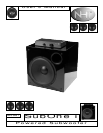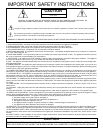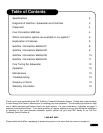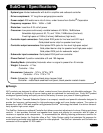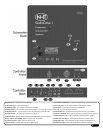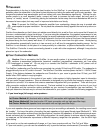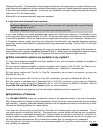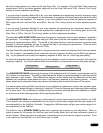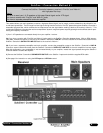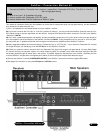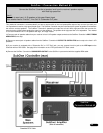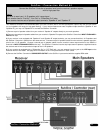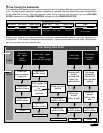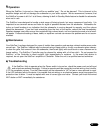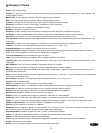
Use of the LFE Input and LFE gain Control (LFE = Low Frequency Effects)
If you receiver/processor has a "subwoofer out" or "LFE out" jack, you can connect that jack to the LFE Input
on the back of the SubOne i Controller. You can configure your system as follows:
(a) This is the recommended method as it the most likely to lead to optimum results for both music and movies.
Connect your receiver/processor as shown in the section labeled Connection Method #1. Connect the LFE out-
put of your receiver to the LFE Input of the Controller as discussed above. Using music, adjust the Controller
so that the main speakers and the subwoofer are well integrated (see the fine tuning section for help). Set up
your receiver/processor so that the main speakers are run in the "large" mode and set the subwoofer to "on" or
"yes." Use the LFE gain control to add the desired level of low frequency effects (in conjunction with the
Audio/Video switch) for home theater use. Also, in the set up of your receiver/processor, set the crossover fre-
quency for the subwoofer to the highest frequency available (typically 200Hz) so that the crossover in the
receiver does not interfere with the crossover in the SubOne i Controller. Also, disable any bass equalization
controls that may be available in the receiver/processor.
Note: Setting the speakers as "large" means that they will be fed a full range signal. They may or may not
receive the information from the low frequency effects channel depending on the bass management features of
your receiver/processor. Therefore we recommend that you set the subwoofer setting to "on" as above to insure
that the SubOne i receives input from the LFE channel. Setting the speakers to "small" means that they are
rolled off below 80Hz, limiting the amount of bass information they must reproduce (and they receive no infor-
mation from the low frequency effects channel). Setting the main speakers to small is not necessary when they
are properly integrated with the SubOne i since the subwoofer and main speakers together form a full range
system.
(b) Run an interconnect from the LFE output on your receiver/processor to the LFE Input on the SubOne i
Controller. DO NOT CONNECT THE RECEIVER TO THE LINE IN AND SATELLITE OUT CONNECTORS ON
THE CONTROLLER (THERE SHOULD BE ONLY ONE INTERCONNECT GOING FROM THE
RECEIVER/PROCESSOR TO THE CONTROLLER). Use the receiver/processor to adjust the settings for
crossover frequency and level for the main speakers and subwoofer. Set the Low Pass filter on the Controller
to its highest setting (180Hz) so that it doesn't interfere with the receiver/processor setting. Set the LFE Gain
control and volume control on the Controller so that the indicator marks on each are pointing straight up. Adjust
as necessary to accommodate the controls provided by your receiver/processor. Note: The control settings
offered by most receiver/processors are somewhat generic, so we recommend method A above since it allows
you to customize the subwoofer settings to your particular system.
The front panel FLAT / VIDEO CONTOUR switch allows you to optimize the SubOne i’s performance for music
listening or movie viewing. When listening to music, many listeners prefer a flat bass response that does not
emphasize any individual frequencies. Flat bass response more realistically reproduces the sound of live instru-
ments. However, when watching movies in a home theater system, many listeners prefer a punchier, “boomi-
er” sound that emphasizes sounds like explosions and gunfire. Subwoofers with more output in the mid-bass
regions tend to deliver this punch, at the expense of flat response.
The Flat / Video Contour switch allows you the best of both worlds. In the “Flat” mode, the SubOne i’s response
is flat for accurate musical reproduction. In the “Video Contour” mode, the SubOne i has boosted output
between 40Hz and the low pass frequency, and rolls off response below 35Hz to provide greater power han-
dling at elevated listening levels.
If your main speakers are large with generous bass response and you are connecting them full-range, you will
most likely be using the SubOne i only for very low bass reinforcement (usually below about 40Hz). In this case,
the “Video Contour” mode will not yield an increase in bass output at these frequencies, but will actually
decrease its output, so the “Flat” mode may work better.
The continuously adjustable LOW PASS FILTER determines the range of frequencies that the subwoofer will
reproduce. For example, a low pass setting of 100Hz means that the subwoofer reproduces only frequencies
below 100Hz. The Low Pass Filter is variable between 50Hz (low bass) to 200Hz (upper bass), to accommo-
date a variety of speaker configurations.
If you are using Connection Method #1, your main speakers are reproducing only the frequency range
selected by the High Pass Filter (see next section). As a starting point, set the Low Pass Filter at
6



